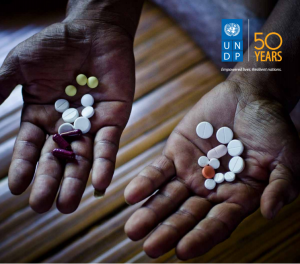 The United Nations Development Programme (UNDP) has published a new set of guidelines for patent examination with a primary view to sieve poor and weak pharmaceutical applications out of the patent pool. In writing the foreword, Director of HIV, Health and Development, UNDP Mandeep Dhaliwal rightly observes that an appropriate balance should be maintained between protecting the rights of inventors and incentivizing innovation, on the one hand, and promoting accessibility and affordability of treatments, on the other. These guidelines have been drafted by Argentine Prof. Carlos M Correa, who much like his highly acclaimed baseball hurling namesake, is widely known for throwing a mean punch against patenting at the cost of public health. Currently, he is the Director of the Centre for Interdisciplinary Studies on Industrial Property and Economics Law, at the University of Buenos Aires. Know more about him here.
The United Nations Development Programme (UNDP) has published a new set of guidelines for patent examination with a primary view to sieve poor and weak pharmaceutical applications out of the patent pool. In writing the foreword, Director of HIV, Health and Development, UNDP Mandeep Dhaliwal rightly observes that an appropriate balance should be maintained between protecting the rights of inventors and incentivizing innovation, on the one hand, and promoting accessibility and affordability of treatments, on the other. These guidelines have been drafted by Argentine Prof. Carlos M Correa, who much like his highly acclaimed baseball hurling namesake, is widely known for throwing a mean punch against patenting at the cost of public health. Currently, he is the Director of the Centre for Interdisciplinary Studies on Industrial Property and Economics Law, at the University of Buenos Aires. Know more about him here.
The Guidelines stress upon the flexibility TRIPS has provided its member nations by not having defined the term “invention”; which empowers them to customize terms of patentability in accordance with their respective socio-economic environment. In light of this flexibility, the Guidelines have made recommendations to aid patent examiners to effectively apply these standards of patentability in such a manner as to prevent protection to unworthy pharmaceutical patents and make way for entry of generic competition in the field. They are clear in their approach, however, that they do not intend to alter or add to the present patentability standards as set by law. For one, the Guidelines recommend that materials found in nature (such as genes) and properties and forms newly found in known products should not be deemed to be inventions. Furthermore, they clearly assert that inventions must always be understood to have a technological effect.
A Quadripartite Justification
Prof. Correa adumbrates four reasons for adopting these Guidelines. Firstly, because there are elements of pharmaceutical patent claims which are unique and have greater impact on public health in comparison with other inventions. Second, because, the Guidelines will speed up patent procedures, help increase uniformity in treating pharmaceutical patent applications and offer applicants greater certainty about the possible outcome of the examination procedure. Thirdly, because there has been a proliferation of pharmaceutical patent applications claiming the likes of polymorphs, salts, formulations and selections which are almost always lack any genuine inventive merit and are filed with an intent to curb generic competition. Lastly, because patent offices and examiner play a pivotal role in establishing and maintaining the balance between patent protection and access to patented products.
Recommendations
The Guidelines systematically identify and make recommendations on issues which may affect larger public interest. These include the traditional patentability standards of novelty, inventiveness, industrial applicability and sufficiency of disclosure. Prof. Correa suggests that an assessment of novelty must necessarily enquire into what has been expressly, implicitly or inherently disclosed in the prior art and states that the discovery of a previously unknown property of a substance does not render the substance patentable. He cautions against grating patents to inventions which merely purport to have found an unexpected solution to a problem. Instead, he recommends that a claimed invention should be assessed in the light of the knowledge of either an expert or a team of experts.
The Guidelines strongly recommend nations to set out specific (and more stringent) standards for pharmaceutical patents and encourage patent offices to exploit the flexibilities allowed by the TRIPS Agreement with regard to the above-mentioned standards. They also identify specific claims which are typical in the pharmaceutical sector viz. markush claims, selection patents, polymorphs, salts, enantiomers, esters and ethers, compositions, does, combinations, prodrugs, metabolites and new medical uses. In particular, Prof. Correa clearly states that polymorphs should be denied patent protection because they lack inventive activity. This is because obtaining a polymorph is a routine activity in pharmaceutical production, carried out through methods widely known to a person skilled in the art. Similarly, Prof. Correa observes that the preparation of salts, esters and esters with advantageous properties over the drug in its free base/acid form will normally face an objection of lack of inventive step because they are almost always a part of the common knowledge of a person skilled in the art. He recommends that such generic references to the respective forms in patent applications covering a compound or active ingredients should not be allowed.
Conclusion
The Guidelines acknowledge at the very outset the fact that developing countries like India prioritize public interest over mindless patent protection and have accordingly enacted legislation to that effect. It is therefore heartening to see that the Guidelines have at several occasions quoted and relied upon the Indian Patent Act 1970, “the Revised Draft Guidelines for Examination of Patent Applications in the Field of Pharmaceuticals” and even judicial precedents from India to drive home its points of recommendation. Unfortunately though, the Indian government seems determined to work in the exact opposite direction; mainly in compliance with US demands.